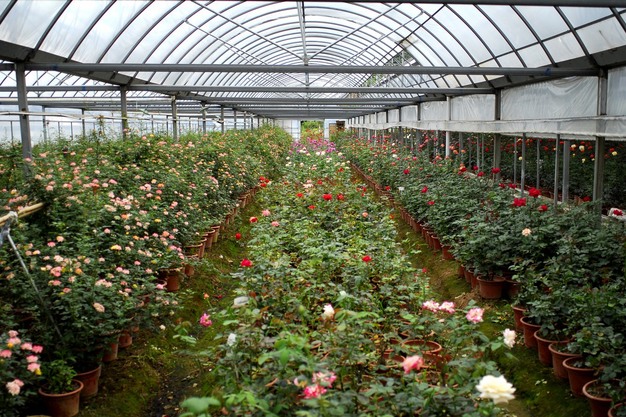A common sight this time of year is Landscape Services workers planting colorful flowers in beds of mulch and hanging pots of beautiful blossoms across the Indiana University Bloomington campus.
Begonias and petunias have been staples. Canna lilies are new this year.
It's all part of annual beautification efforts.
Before finding a home on campus, the festive flora is grown in two greenhouse buildings in a secluded area near The Pfau Golf Course. And this semester, many of those blossoms started in a new greenhouse that aids sustainability and energy efficiency —– which IU champions in its Climate Action Plan.
The new greenhouse opened in January to replace an older one that was less energy efficient and beyond its useful life, said Michael Gregory, the nursery head. The new building has automated environmental controls, including a weather station that monitors temperature, humidity and wind speed. The roof and sides of the building can open automatically to regulate temperature and humidity and dissipate heat. Small fans overhead circulate the air to aid plant growth and temperature control.
 © Shuxiaoyu | Dreamstime.com
© Shuxiaoyu | Dreamstime.com
"It's better for the people and work environment," Gregory said. "It's better for the plants because there's less chance of failure because of heat. It's better for the environment; there's no top watering because we use bottom watering and can save water and fertilizer. We can grow more because of better growing tables."
Look inside the new greenhouse and you'll see large pots of begonias and canna lilies on one side. Baskets of begonias hanging from poles will eventually be hung from light posts on campus. The baskets of petunias will be placed in locations such as the Sample Gates and Showalter Fountain.
Metal growing tables hold petunias, pink bubble grass, purple fountain grass, coleus and canna lilies in various stages of growth.
The metal tables are new, replacing wood tables. They can slide to either create aisles or maximize the growing area. The metal tables are designed to hold water, and channels on the bottom allow a mixture of water and fertilizer to be applied from the bottom and soaked up by the flowers, plants and grasses instead of sprayed overhead.
An automated system sucks concentrated fertilizer from a bucket and injects it into a watering system that delivers the mixture to the growing tables.
"This is very even and uniform watering and fertilizing," Gregory said. "The plants, flowers and grasses grow very well and uniformly. There's less issue of uneven watering and fertilizing. Each gets what it needs."
The older building next door is humid and warm inside. Big fans in the walls blow in air, but temperature regulation is challenging with outdated controls.
"It's more problematic in here," Gregory said. "If the heat fails in the winter, the flowers and plants can't tolerate the cold too long."
The hope is to replace the older greenhouse building in the near future, Gregory said.
As part of IU Bloomington's sustainability efforts, all spent flowers and plants are composted in an area near the greenhouses, said Nicholas Nehring, nursery assistant. Organic tree waste generated on campus by the arborists is chipped and added to the compost mix.
One compost pile is from the previous year, one is from two years ago and another is three years old. The piles are turned periodically to break up clumps and aid decomposition. Doing so increases the organic matter for reuse, Nehring said. After the matter is finished breaking down over a three-year cycle, it's used for top dressing of the beds in the spring.
These efforts, as with those to grow the flowers and plants, result in a picturesque campus.
"IU Landscape Services has always prided itself on helping IU Bloomington rank as one of the most beautiful campuses in the country," said Tristan Johnson, director of Landscape Services. "All of these innovations allow for a much more efficient growing environment, from both a water and energy conservation standpoint. Production quality has improved, which means we can produce an even more spectacular annual flower display for students, faculty, staff and visitors to enjoy."
Source: iu.edu
